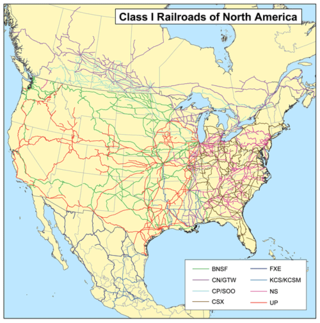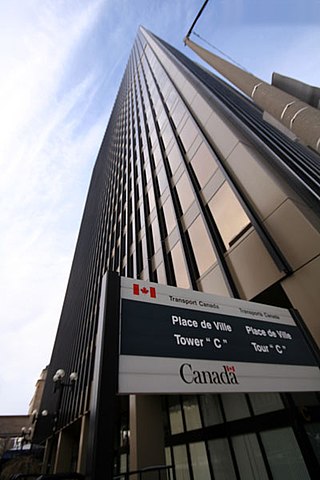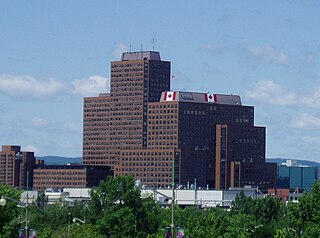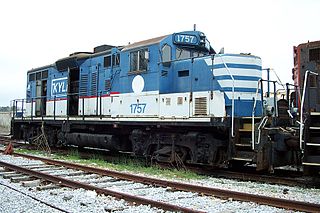Related Research Articles

Canada, the world's second-largest country in total area, is dedicated to having an efficient, high-capacity multimodal transportation spanning often vast distances between natural resource extraction sites, agricultural and urban areas. Canada's transportation system includes more than 1,400,000 kilometres (870,000 mi) of roads, 10 major international airports, 300 smaller airports, 72,093 km (44,797 mi) of functioning railway track, and more than 300 commercial ports and harbours that provide access to the Pacific, Atlantic and Arctic oceans as well as the Great Lakes and the St. Lawrence Seaway. In 2005, the transportation sector made up 4.2% of Canada's GDP, compared to 3.7% for Canada's mining and oil and gas extraction industries.

The Interstate Commerce Commission (ICC) was a regulatory agency in the United States created by the Interstate Commerce Act of 1887. The agency's original purpose was to regulate railroads to ensure fair rates, to eliminate rate discrimination, and to regulate other aspects of common carriers, including interstate bus lines and telephone companies. Congress expanded ICC authority to regulate other modes of commerce beginning in 1906. Throughout the 20th century, several of ICC's authorities were transferred to other federal agencies. The ICC was abolished in 1995, and its remaining functions were transferred to the Surface Transportation Board.

Railroad classes are the system by which freight railroads are designated in the United States. Railroads are assigned to Class I, II or III according to annual revenue criteria originally set by the Surface Transportation Board in 1992. With annual adjustments for inflation, the 2019 thresholds were US$504,803,294 for Class I carriers and US$40,384,263 for Class II carriers.
Railroad police or railway police are people responsible for the protection of railroad properties, facilities, revenue, equipment, and personnel, as well as carried passengers and cargo. Railroad police may also patrol public rail transit systems.

Transit police are specialized police agencies employed either by a common carrier, such as a transit district, railway, railroad, bus line, or another mass transit provider or municipality, county, district, or state.

The minister of transport is a minister of the Crown in the Canadian Cabinet. The minister is responsible for overseeing the federal government's transportation regulatory and development department, Transport Canada, as well as Canada Post, the Saint Lawrence Seaway, Nav Canada, and the Port Authority system. Since 26 July 2023, the position has been held by Pablo Rodriguez of the Liberal Party.

Transport Canada is the department within the Government of Canada responsible for developing regulations, policies and services of road, rail, marine and air transportation in Canada. It is part of the Transportation, Infrastructure and Communities (TIC) portfolio. The current Minister of Transport is Pablo Rodriguez. Transport Canada is headquartered in Ottawa, Ontario.

The Federal Railroad Administration (FRA) is an agency in the United States Department of Transportation (DOT). The agency was created by the Department of Transportation Act of 1966. The purpose of the FRA is to promulgate and enforce rail safety regulations, administer railroad assistance programs, conduct research and development in support of improved railroad safety and national rail transportation policy, provide for the rehabilitation of Northeast Corridor rail passenger service, and consolidate government support of rail transportation activities.

The Montreal, Maine and Atlantic Railway was a Class II freight railroad that operated in the U.S. states of Maine and Vermont and the Canadian province of Quebec between 2002 and 2014. It was headquartered in Hermon, Maine.

Rail transportation in the United States consists primarily of freight shipments along a well integrated network of standard gauge private freight railroads that also extend into Canada and Mexico. The United States has the largest rail transport network of any country in the world, about 160,000 miles (260,000 km).
Standards for North American railroad signaling in the United States are issued by the Association of American Railroads (AAR), which is a trade association of the railroads of Canada, the US, and Mexico. Their system is loosely based on practices developed in the United Kingdom during the early years of railway development. However, North American practice diverged from that of the United Kingdom due to different operating conditions and economic factors between the two regions. In Canada, the Canadian Rail Operating Rules (CROR) are approved by the Minister of Transport under the authority of the Railway Safety Act. Each railway company or transit authority in Canada issues its own CROR rulebook with special instructions peculiar to each individual property. Among the distinctions are:
OmniTRAX, Inc. is a transportation and transportation infrastructure holding company based in Denver, Colorado, in the United States. It primarily owns or operates railroads, with a network of 25 regional and shortline railroads in 12 U.S. states and three Canadian provinces. It is one of the largest privately owned railroad companies in the United States. The firm also invests in, develops, and operates ports, multimodal transportation terminals, and industrial parks.

The Canadian Transportation Agency is the independent, quasi-judicial tribunal of the Government of Canada that makes decisions relating to federally-regulated modes of transportation. Its headquarters are in the Jules Léger Building (South) in Terrasses de la Chaudière, Gatineau, Quebec.

Rail speed limits in the United States are regulated by the Federal Railroad Administration. Railroads also implement their own limits and enforce speed limits. Speed restrictions are based on a number of factors including curvature, signaling, track condition, and the presence of grade crossings. Like road speed limits in the United States, speed limits for tracks and trains are measured in miles per hour (mph).

A shortline railroad is a small or mid-sized railroad company that operates over a relatively short distance relative to larger, national railroad networks. The term is used primarily in the United States and Canada. In the former, railroads are categorized by operating revenue, and most shortline railroads fall into the Class III or Class II categorization defined by the Surface Transportation Board.
Dark territory is a term used in the North American railroad industry to describe a section of running track not controlled by signals. Train movements in dark territory were previously handled by timetable and train order operation, but since the widespread adoption of two way radio communications these have been replaced by track warrants and direct traffic control, with train dispatchers managing train movements directly. Today most dark territory consists of lightly used secondary branch lines and industrial tracks with speeds ranging between 25 miles per hour (40 km/h) and 40 miles per hour (64 km/h); however, there do exist a small minority of main lines that fall into the category.

The Southern Ontario Railway is a shortline railroad in the province of Ontario, owned and operated by Genesee & Wyoming Canada Inc., the Canadian subsidiary of Genesee & Wyoming Inc. It operated 69 miles (111 km) of track from Brantford to Nanticoke, Ontario, from 1998 to 2018. The railroad began operations in 1998, and was acquired by RailAmerica two years later. It had interchanges with the Canadian National Railway at Hamilton via trackage rights, Brantford and Paris, and interchanges with the Canadian Pacific Railway at Hamilton.
The Grand Forks Railway is a shortline railway company operating in the West Kootenay region of southeastern British Columbia.

The Lac-Mégantic rail disaster occurred in the town of Lac-Mégantic, Quebec, Canada, on July 6, 2013, at approximately 1:14 a.m. EDT, when an unattended 73-car Montreal, Maine and Atlantic Railway (MMA) freight train carrying Bakken Formation crude oil rolled down a 1.2% grade from Nantes and derailed downtown, resulting in the explosion and fire of multiple tank cars. Forty-seven people were killed. More than thirty buildings in Lac-Mégantic's town centre were destroyed, and all but three of the thirty-nine remaining buildings had to be demolished due to petroleum contamination. Initial newspaper reports described a 1 km (0.6-mile) blast radius.

In rail transport, the U.S. DOT-111 tank car, also known as the TC-111 in Canada, is a type of unpressurized general service tank car in common use in North America. Tank cars built to this specification must be circular in cross section, with elliptical, formed heads set convex outward. They have a minimum plate thickness of 7⁄16 inch (11.1 mm) and a maximum capacity of 34,500 US gallons. Tanks may be constructed from carbon steel, aluminum alloy, high alloy steel, or nickel plate steel by fusion welding.
References
- ↑ downloadable PDF copy of the RSA Review
- ↑ Terms of reference of the RSA Review
- ↑ Text of section 4.3 of RSA Review
- ↑ Canadian Transportation Decision No. 33-R-2009 http://www.otc-cta.gc.ca/decision-ruling/decision-ruling.php?id=28134&lang=eng
- 1 2 3 Section 88 Canada Transportation Act http://laws-lois.justice.gc.ca/eng/acts/C-10.4/section-88.html
- ↑ "Federal Railway Companies". Canadian Transportation Agency. 7 October 2010. Retrieved 24 April 2011.
- ↑ Canadian Transportation Agency Order No. 2005-R-277 http://www.otc-cta.gc.ca/decision-ruling/drv.php?id=23347&lang=eng
- ↑ "Order No. 2013-R-266". 13 August 2013.
- ↑ Railway Association of Canada - Ottawa Valley Railway http://www.railcan.ca/sec_rac/en_rac_member_profile.asp?id=86
- 1 2 "Appendix E: Profile of Railway Companies as of November 2007". Transport Canada. November 2007. Archived from the original on December 30, 2018.
- ↑ "Shortline Railways Act, 1995, S.O. 1995, c. 2". Ontario.ca. 24 July 2014. Retrieved July 24, 2018.
- ↑ "2011, c.220, Shortline Railways Act". Ontario.ca. Retrieved May 11, 2020.
- ↑ "Part I. General". Rules Respecting Track Safety. Transport Canada. 3 November 2008. Retrieved 24 April 2011.
- 1 2 "A. Classes of Track". Rules Respecting Track Safety. Transport Canada. 3 November 2008. Archived from the original on 25 August 2012. Retrieved 24 April 2011.
- ↑ Compare above table with "Archived copy" (PDF). Archived from the original (PDF) on 2008-05-28. Retrieved 2010-02-26.
{{cite web}}: CS1 maint: archived copy as title (link) and "Archived copy" (PDF). Archived from the original (PDF) on 2003-09-23. Retrieved 2012-11-04.{{cite web}}: CS1 maint: archived copy as title (link) - ↑ "Excepted track". Rules Respecting Track Safety. Transport Canada. 3 November 2008. Retrieved 2013-08-15.
- ↑ Service Equipment Cars Regulations http://laws-lois.justice.gc.ca/eng/regulations/SOR-86-922/FullText.html
- ↑ "F. Inspection". Rules Respecting Track Safety. Transport Canada. 3 November 2008. Retrieved 24 April 2011.
- ↑ Section 44, Railway Safety Act http://laws-lois.justice.gc.ca/eng/acts/R-4.2/section-44.html
- 1 2 3 Work/Rest Rules for Railway Operating Employees Transport Canada http://www.tc.gc.ca/eng/railsafety/rules-tco140-364.htm